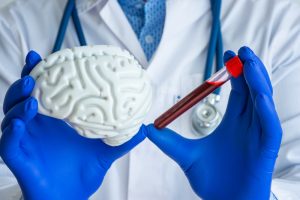Menopause brings many changes. These also affect the brain. According to research published in the online edition of Neurology®, the medical journal of the American Academy of Neurology, postmenopausal women may have more of a brain biomarker called white matter hyperintensities than premenopausal women or men of the same age.
White Matter Hyperintensities Differ in Males And Females
White matter hyperintensities are tiny lesions visible on brain scans that are more common with age or with uncontrolled high blood pressure. These brain biomarkers have been linked to an increased risk of stroke, Alzheimer’s disease and cognitive decline in some studies.
White matter hyperintensities increase as the brain ages, and while they don’t mean a person will develop dementia or have a stroke, larger amounts can increase the risk. The study examined what role menopause might play in the levels of these brain biomarkers. The results show that white matter hyperintensities develop differently in men and women, with menopause or factors determining the onset of menopause such as variations in the aging process, are crucial.
Faster Increase in Biomarkers in The Female Brain
After accounting for age and vascular risk factors such as high blood pressure and diabetes, the researchers found that postmenopausal women had more of these brain biomarkers compared to men of a similar age. In subjects 45 years and older, postmenopausal women had a mean total volume of white matter hyperintensities of 0.94 mL compared to 0.72 mL in men. The researchers also found that the increase in brain biomarkers accelerated with age and was faster in women than in men. Premenopausal women and men of similar age had no difference in the mean amount of white matter hyperintensity.
The researchers also found that postmenopausal women had more white matter hyperintensities than premenopausal women of a similar age. Regardless of menopausal status, women with uncontrolled hypertension had higher levels of this brain biomarker compared to men. Hypertension, which affects the small blood vessels in the brain, can cause white matter hyperintensities to increase. These results underscore the importance of gender-specific medicine and more attentive therapy for older women, particularly those with vascular risk factors.
Menopause Linked to Lower Glucose Metabolism in The Brain
According to research, women are also more prone to brain diseases like Alzheimer’s. Metabolic changes can be responsible for this. For the study, researchers at the University of Arizona Health Sciences in Tucson used positron emission tomography (PET) imaging to measure the use of glucose (a major fuel source for cellular activity) in the brains of 43 healthy women aged 10 to 12 40 to 60 years. Of these, 15 were premenopausal, 14 in transition to menopause (perimenopause) and 14 in menopause.
The tests showed that those women who had been through menopause or were perimenopausal had significantly lower glucose metabolism in several key regions of the brain than those who were premenopausal. Scientists have seen a similar pattern of “hypometabolism” in the brains of patients in the earliest stages of Alzheimer’s disease in previous studies, and even in mice modeling the disease.
Antioxidants in The Fight Against Alzheimer’s
In addition, menopausal and perimenopausal patients showed lower levels of activity for a key metabolic enzyme called mitochondrial cytochrome oxidase, as well as lower scores on standard memory tests. The strong contrast with premenopausal patients persisted, even taking into account that the menopausal and perimenopausal women were older. During menopause, women lose an important neuroprotective element in the brain and are at greater risk of brain aging and Alzheimer’s due to estrogen loss. According to the researchers, the drop in estrogen at menopause can trigger a shift to a starvation response in the brain, a metabolic state that is beneficial in the short term but can be harmful in the long term.
The findings add to the growing body of evidence that there is a physiological link between menopause and Alzheimer’s, and suggest that women may need antioxidants to protect their brain activity and mitochondria in combination with strategies to maintain estrogen levels.






